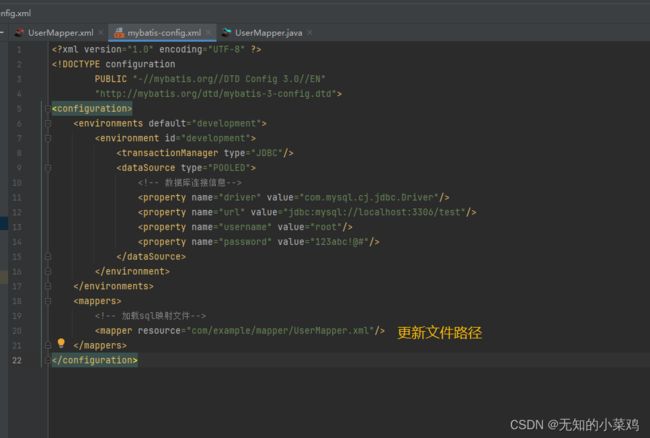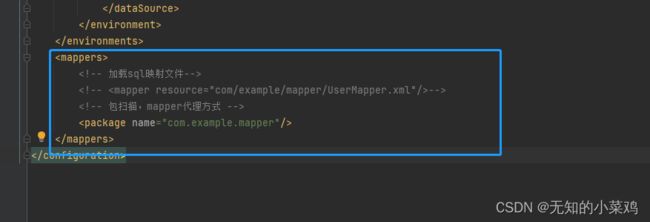MyBatis学习二:Mapper代理开发、配置文件完成增删改查、注解开发
前言
公司要求没办法,前端也要了解一下后端知识,这里记录一下自己的学习
学习教程:黑马mybatis教程全套视频教程,2天Mybatis框架从入门到精通
文档:
https://mybatis.net.cn/index.html
Mapper代理开发
目的
- 解决原生方式中的硬编码
- 简化后期执行sql
Mapper代理要求
- 定义与sql映射文件同名的Mapper接口,并且将Mapper接口和sql映射文件放置在同一目录下
- 设置sql映射文件的
namespace属性未Mapper接口全限定名 - 在Mapper接口中定义方法,方法名就算sql映射文件中sql语句的id,并保持参数类型和返回值类型一致
- 编码
- 通过
SqlSession的getMapper方法获取Mapper接口的代理对象 - 调用对应方法完成sql的执行
- 通过
备注: 如果Mapper接口名称和sql映射文件名称相同,并且在同一目录下,则可以使用包扫描的方式简化sql映射文件的加载。
定义Mapper接口,并且将Mapper接口和sql映射文件放置在同一目录下

1、在java/com/mapper下创建一个UserMapper接口文件
2、在resources下创建相同的目录结构,com/example/mapper,将UserMapper.xml移入到该目录下
3、注意,创建完成后在文件管理器里看一下目录结构是否正确,com.example.mapper是三个文件夹,不是一个文件夹。视频里也说了,这个很重要

设置sql映射文件的namespace属性未Mapper接口全限定名
修改UserMapper.xml文件里的namespace属性,修改为com.example.mapper.UserMapper

在Mapper接口中定义方法,方法名就算sql映射文件中sql语句的id,并保持参数类型和返回值类型一致

更新mybatis-config.xml里映射文件的地址

修改测试类
// 3、执行sql语句,查询所有数据
// 指定要执行的sql语句,这里传入对应的标识,对应UserMapper.xml文件中<select id="selectAllUser" resultType="User">
// List<User> userList = sqlSession.selectList("test.selectAllUser");
// 3.1 获取UserMapper接口的代理对象
UserMapper userMapper = sqlSession.getMapper(UserMapper.class);
// 3.2 执行查询
List<User> userList = userMapper.selectAllUser();
执行结果

使用包扫描的方式简化sql映射文件的加载
mybatis-config.xml

配置文件完成增删改查
基本步骤
- 编写Mapper接口方法
- 编写sql语句,在sql映射文件里
实体类属性与表字段不一致
例如:类属性是userName,表里的属性是user_name。这样导致无法正确的查询出结果。
解决方式是设置:resultMap
原代码
<select id="selectAllUser" resultType="com.example.pojo.User">
select * from user;
</select>
修改后
<resultMap id="userResultMap" type="com.example.pojo.User">
<!-- property 属性是指对应的 Java 类的属性,column 属性是指对应的数据库表的字段名 -->
<!-- 主键映射-->
<id property="id" column="id"/>
<!--普通列映射-->
<result property="userName" column="user_name"/>
</resultMap>
<select id="selectAllUser" resultMap="userResultMap">
select * from user;
</select>
根据id进行数据查询
UserMapper 接口
// 根据id查询
User selectUserById(Integer id);
UserMapper.xml
<select id="selectUserById" parameterType="int" resultType="com.example.pojo.User">
select * from user where id = #{id};
</select>
测试
// 根据id进行查询
User user = userMapper.selectUserById(1);
System.out.println("用户:" + user);
补充:
parameterType用于指定参数类型,这个也可以省略,因为mapper接口李的函数已经指定了参数类型- 参数使用
#{参数}进行传递,除了#{}还存在${}。#{}会将参数替换为?,可以防止sql注入;${}会显示为实际的值,会存在sql注入问题。 - 特殊字符,因为是在
xml中写sql,所以<和<=会与xml标签冲突,<可以使用<代替,<=使用<=代替
条件查询
多条件查询
- 参数同属于一个对象时
UserMapper接口里的函数
List<User> selectUserById(User user);
测试的代码
// 根据id和年龄进行查询
User userParam = new User();
userParam.setId(2);
userParam.setAge(30);
List<User> user = userMapper.selectUserById(userParam);
System.out.println("用户:" + user.size());
UserMapper.xml里的sql
<select id="selectUserById" resultType="com.example.pojo.User">
select * from user where id <#{id} and age < #{age};
select>
使用对象的这种方式要注意:当你调用这个方法时,将会把 user.getId() 的值传递给SQL语句中的#{id}参数。但是要确保 User 类中有一个名为 id 的属性,并且提供了对应的getter方法。
- 参数不属于一个对象时
UserMapper接口里的函数,需要使用@Param指定参数名称
List<User> selectUserById(@Param("id") int id, @Param("age") int age);
测试的代码
List<User> user = userMapper.selectUserById(3,10);
UserMapper.xml里的sql,#{}里的变量要与@Param定义的保持一致
<select id="selectUserById" resultType="com.example.pojo.User">
select * from user where id <#{id} and age < #{age};
select>
- 参数是一个
map对象
这里只需要注意map对象的key要与sql里的参数保持一致
动态条件查询
if 条件判断
<select id="selectUserById" resultType="com.example.pojo.User">
select * from user where id <#{id}
<if test="age !=-1 and age <100">
and age < #{age}
if>
select>
如果id 和 age都需要判断时可以采用下面的方式
<select id="selectUserById" resultType="com.example.pojo.User">
select * from user
<where>
<if test="id!=-1">
and id = #{id}
if>
<if test="age!=-1">
and age = #{age}
if>
where>
select>
但条件动态查询
使用choose,when,otherwise,类似于switch,case,default
select * from user where
<choose>
<when test="id!=-1">
id = #{id}
when>
<when test="age!=-1">
age = #{age}
when>
<otherwise>
1=1
otherwise>
choose>
或者
select * from user
<where>
<choose>
<when test="id!=-1">
id = #{id}
when>
<when test="age!=-1">
age = #{age}
when>
choose>
where>
添加、修改
添加
UserMapper接口
// 添加用户
void addUser(User user);
UserMapper.xml
<insert id="addUser" useGeneratedKeys="true" keyProperty="id">
insert into user(name, age, email)
values (#{name}, #{age}, #{email});
insert>
测试代码
User newUser = new User();
newUser.setName("李四");
newUser.setAge(18);
newUser.setEmail("[email protected]");
userMapper.addUser(newUser);
// 这里要手动提交一下事务
sqlSession.commit();
System.out.println("新添加的id是:" + newUser.getId());
动态修改
<update id="updateUser">
update user
<set>
<if test="name!=null">
name = #{name},
if>
<if test="age!=null">
age = #{age},
if>
<if test="email!=null">
email = #{email}
if>
set>
<where>
id = #{id}
where>
update>
删除
删除一个
<delete id="deleteUserById">
delete from user
where id = #{id}
delete>
批量删除
void deleteUserByIds(@Param("ids") int[] ids);
<delete id="deleteUserByIds">
delete from user
where id in
<foreach collection="ids" item="id" open="(" separator="," close=")">
#{id}
foreach>
delete>
参数传递
当接口的参数是Collection、List、Array、多个参数时需要使用@Param注解,来给参数命名,确保sql中可以正确识别,如上面的批量删除。
注解开发
前面开发时sql语句都是写在xml,配置文件里。这里使用注解可以代替配置文件的方式,更加方便。
当然如果sql语句比较复杂还是使用配置文件的方式。
注解
- 查询:
@Select - 添加:
@insert - 修改:
@Update - 删除:
Delete
以查询用户为例
xml配置方式
List<User> selectAllUser();
<select id="selectAllUser" resultMap="userResultMap">
select *
from user;
select>
注解方式
@Select("select * from user where name = #{name}")
User selectUserByName(String name);
